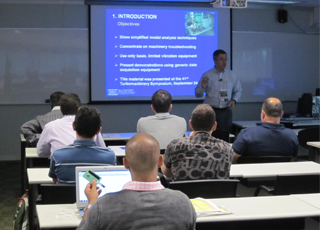Services > Rotordynamics > Torsional Dynamics
Torsional Dynamics
Torque fluctuations within machine trains can yield torsional vibrations and stresses sufficient to cause undetected and catastrophic shafting failures.
In some cases, resolving a problem may require measurement of the machine's torsional vibrations using special instrumentation. BRG performs such vibration analysis when clients need these specialized field measurements.
BRG conducts several different types of analysis to help ensure such torsional failures are avoided:
Undamped Critical Speed Analysis
Forced Response Analysis
Transient & Nonlinear Analysis
Torsional Dynamics Analyses
Undamped Critical Speed Analysis
Potential interferences between train natural frequencies and torque excitation sources are identified. In addition, the influences of torque distribution and coupling design can be assessed using the resulting mode shapes.
Mode shape for an integrally geared compressor train that experienced a catastrophic torsional fatigue failure after 125 starts
Campbell diagram for compressor train driven
by a 9 MW synchronous motor
Forced Response Analysis
Small torsional damping within many trains causes some interferences to be well amplified resulting in large torsional vibrations. To determine the stresses caused by such vibrations, this analysis applies steady state oscillating torques. Locations with high stress concentration factors, such as keyways, are examined for their safety factor against high cycle fatigue failure.
Alternating shear stresses created by a torsional interference within a turbine driven boiler feedwater pump
Finite element analysis results to determine stress concentration factors at fillet radius locations within a compressor shaft
Transient & Nonlinear Analysis
Train startups and electrical events, such as short circuit and recloser faults, require analysis in the time domain. Such events and their resulting motions can also be nonlinear due to the presence of gear backlash, elastomeric or torque-limited couplings. Transient analysis, in conjunction with cumulative fatigue damage analysis, provides a vital tool for evaluating components' life when subjected to these events.
Torsional shear stresses causing low cycle fatigue during a plant air compressor's startup
Torque transients created due to a 3 phase short circuit within a 100 MW generator

